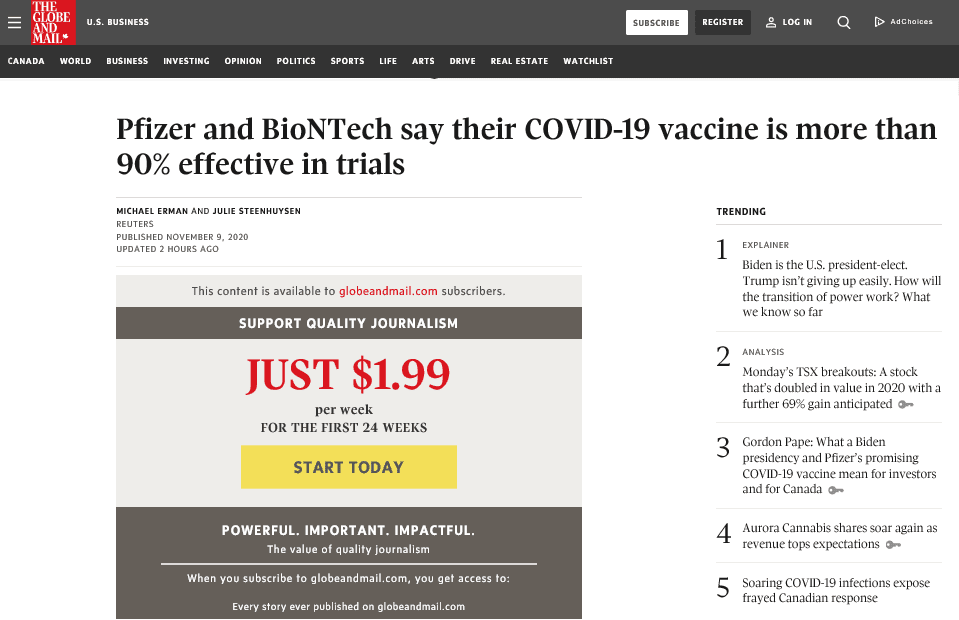|
Getting your Trinity Audio player ready...
|
“The results were stunning. We ended up with millions of dollars in incremental revenue.”
When any news organisation starts down the path of paywalled content, one big question that they face is the question of which content to paywall.
At The Globe and Mail, Canada’s national newspaper, we put up a paywall in 2012. We were one of the few newspapers in the world to have a paywall at the time. It was a major decision, one that we knew we had to take in order to build a thriving, sustainable business that would continue to support ambitious journalism.
But how do you tell readers that they will now need to pay for something that they had typically been able to access free of cost? Worse, what if you ask them to pay after they’ve just been browsing through content that they don’t really value?
We also had to win our newsroom over. Part of the challenge there was the tension between what they believed was the public’s right to know useful information and the business’s desire to restrict content that can drive revenue.
Another part of the challenge is the tension between advertising revenue and subscriber revenue: If you paywall content, then you give up advertising revenue that would otherwise be readily available as readers flock to it.
Did we rise to all of these challenges when we faced them? Did we have a silver bullet that solved all our problems overnight? Actually, no.
When we launched a paywall, we used a hybrid model – we had a meter, and we had certain sub-sections or verticals under which every single article was paywalled.

Soon after we introduced our paywall, our newsroom meetings regularly featured arguments over what should go behind the wall and what should stay in front of it. Every editor around the table was involved in a great guessing game about what would drive subscriptions and which content would bring in a mountain of pageviews. It was pure speculation – very few journalists were particularly adept at figuring out the trade-off between reach and subscriptions. There was a lot of sketchy mental math going on as well. Also, the only articles we ever contemplated paywalling were our big bets – content that had the potential to really make an impact. We were completely ignoring smaller secondary stories.
The birth of Sophi.io
Our data science team took this problem away and came back with a question for the newsroom: Would it be all right if they experimented with paywalling some articles that the data suggested would have extremely low traffic anyway? That way, we weren’t giving up a lot of ad revenue if the data scientists decided an article was worth paywalling, and, who knows, it might actually bring in some subscriptions.
The newsroom agreed, and our data scientists went to work. They used a clever natural language processing-based (NLP) artificial intelligence system that we call Sophi to estimate the expected advertising revenue and the expected subscription revenue from every article that we published.
The results were stunning. We ended up with millions of dollars in incremental revenue. Even more astounding, it happened without the newsroom having to change anything that it was already doing.
In other words, we had been leaving money on the table for years. Sophi revealed to us that our readers saw the value in many articles that we published, value that our editors had not recognised because no human being can possibly stay on top of every single article that we publish and get the math right every time.
Automation vs human inputs
Our editors went over the results of the test and suggested that it would be best if Sophi decided which articles to paywall. They were already feeling stretched and overworked and were relieved that Sophi would take on the responsibility of getting this right. Sophi had the capacity to consider both minor and major articles, helping us see beyond the blind spots that our editors had.
Our data science team ensured that our editors had the prerogative to manually override any of Sophi’s decisions that they disagreed with. This has seldom been exercised, except in cases where the newsroom believes that it is in the public interest to be aware of certain news (e.g., on the spread of the coronavirus or wildfires).
We refer to this Sophi paywall as our content-propensity paywall, since Sophi’s NLP technology based the decision to present a paywall on the content that an article contained.
Propensity to pay
What about the challenge of ensuring that we were asking readers to pay at the right time? The right time would be when they had just read an article that they valued – or when they wanted to read an article that they would value. Yet, what I value is surely different from what you value. How could we get this right?
Our data scientists took this problem away as well. They figured out a way to layer in each user’s propensity to pay into the paywall model as well as content propensity. So, I might get a wall after two articles, you might get it after six, and your colleague may never see one because Sophi knows that he will never pay and that we can make ad revenue off him and it knows when to give up and stop bothering him.
As a result, we’ve increased subscription conversion, registration – and, paradoxically, also loyalty and engagement, because we’re not alienating readers who would never pay by asking them to pay.
In this way, we now have a fully dynamic paywall that examines both content and user behaviour. This has led to another million dollars in incremental revenue for us, money that we can put back into funding award-winning journalism.
Sonali Verma
Director of Sophi Customer Success,
The Globe and Mail
About The Globe and Mail and Sophi.io: With 6 million readers every week, The Globe and Mail is Canada’s foremost news media company, leading the national conversation and effecting policy change through independent journalism since 1844. The company invested in innovative data science and hired data scientists from leaders in the tech industry to develop Sophi.io – an artificial intelligence system with predictive capabilities – and used it to automate content curation and promotion, for themselves and other content publishers across the world.



